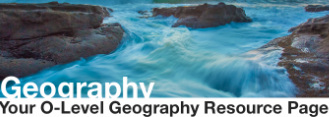Tectonics and Crustal Movements
1. Describe, with the aid of diagram, the internal structure of the earth.
a) The crust is formed when a molten mass of rock and metal cooled. It is the outer layer of the earth and it varies in thickness from 5 to 70km.
i) Continental crust consist of granite and is less dense.
ii) Oceanic crust consist of basaltic rocks and 'float'on the mantle.
b) Mantle is the second layer of the earth's structure. It consist of hot and semi-liquid plastic rock .
c) The outer core is liquid and the inner core consists of solid rock.
2. Explain the Continental Drift Theory (Alfred Wegner)
a) all continents were part of one large land mass called 'Pangea". The continents broke up and pieces drifted apart.
b) Evidence of Theory:
i) outline of S. America fit Africa like a jig-saw puzzle.
ii) similar fossil animals in South America and Africa
iii) similar minerals found in South America and Africa.
iv) Mountain ranges in N.America and N.Europe similar.
a) The crust is formed when a molten mass of rock and metal cooled. It is the outer layer of the earth and it varies in thickness from 5 to 70km.
i) Continental crust consist of granite and is less dense.
ii) Oceanic crust consist of basaltic rocks and 'float'on the mantle.
b) Mantle is the second layer of the earth's structure. It consist of hot and semi-liquid plastic rock .
c) The outer core is liquid and the inner core consists of solid rock.
2. Explain the Continental Drift Theory (Alfred Wegner)
a) all continents were part of one large land mass called 'Pangea". The continents broke up and pieces drifted apart.
b) Evidence of Theory:
i) outline of S. America fit Africa like a jig-saw puzzle.
ii) similar fossil animals in South America and Africa
iii) similar minerals found in South America and Africa.
iv) Mountain ranges in N.America and N.Europe similar.
3. Explain the Plate Tectonic Theory
a) The crust is cracked into pieces called tectonic plates which float on the mantle.
b) Plates move due to convection currents in the mantle.
c) Evidence: i) discoveries of mid-ocean ridges in the Atlantic Ocean and the spreading of the sea floor.
ii) volcanoes, earthquakes and young mountains all occur at the plate boundaries.
a) The crust is cracked into pieces called tectonic plates which float on the mantle.
b) Plates move due to convection currents in the mantle.
c) Evidence: i) discoveries of mid-ocean ridges in the Atlantic Ocean and the spreading of the sea floor.
ii) volcanoes, earthquakes and young mountains all occur at the plate boundaries.
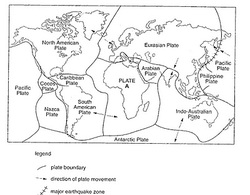
4. Identify the crustal plates on a world map.
5.Explain the types of plate movements and features formed at the boundaries.
a) Divergent plate movement (constructive margin) : when crustal plates move apart, molten rock rises from mantle through a fault line. When it comes in contact with the cold ocean water, the magma solidifies to form ridges. Layer upon layer of such solidified magma is formed on top of each other until an oceanic mountain ridge is formed at the sides of the fault line, eg. mid-Atlantic ridge.
b) Convergent plate movement(destructive margin): when two plates meet head on, one will dip below the other forming deep trenches. This is the result of subduction.
E.g. The Australian plate dip below the Eurasian plate forming the Java Trench. As the oceanic crust is force downward, the molten material (magma) force its way up to the surface through the layers of rocks . This results in the formation of the many volcanoes in Indonesia. When two continental plates converges, the sedimentary rocks in between are compressed and folded. Fold mountains are formed.
c) When two plates slide past each other, a transform fault is formed. e.g. San Andreas
Fault is formed when the Pacific Plate slides past the America Plate.
6. Explain the cause of earthquake
Earthquakes occur at the plate boundary because this is th most active part of the earth’s crust. As plates converge, one plate is being pushed underneath another, and a zone of subduction is formed. As one plate moves over the other, the movement is not smooth because the surface of the crust is not smooth. There is friction and this friction causes the movement to jerk.
The crust is also under great stress when the plates move in opposite direction. The stress in the rocks is so tremendous that it finally causes the rocks to jerk free. The release of tension in the form of seismic waves make the ground vibrate.
7. Explain what is the focus and epicentre of an earthquake.
Focus is the place where the earthquake take place. Epicentre is the point on the surface above the focus.
8. Name the instrument used for recording earthquake and state how the intensity of earthquake is measured.
A seismograph is used for recording earthquake. The intensity of earthquake is measured on the Richter scale graded from 1 to 9. The higher the number, the greater the intensity.
9. Describe the effects of earthquakes.
a) vertical and lateral rupture of the crust
b) Tsunami - giant waves travelling up to 700 km/h
c) collapse of buildings and bridges
d) deaths and injuries
e) disruption to the transport and communication system
f) other hazards such as fire, flooding
g) landslides on steep slopes.
h) supply of water, gas and sewerage disposal disrupted
i) diseases are rampant because of contaminated water and decomposed bodies
j) many are left homeless suffering from shortage of food, clothing, medicine
10. Explain why some earthquakes are more damaging than others.
Some earthquake causes more damage because the intensity of the earthquake differ. Places located near to the epicentre will experience high intensity of the earthquake and thus suffer the greatest amount of damage.
The extent of damage also depends on the amount of development in the areas where earthquake takes place. An earthquake which struck a desert is less damaging than in a city. The foundations of the buildings and bridges are also important because if the foundation is good, it will withstand the vibration. Developed areas suffer more damages as water and gas pipes broke. Urban areas are heavily built up with dense population densities and heavy traffic movements. As residents in big urban areas usually live in high rise buildings because land is scarce in the cities, damage to properties and loss of lives can be phenomenal as the high rise building collapse when earthquakes occur. As building collapse, other related hazards usually occur such as fire from damaged power lines. Destruction to highways, streets, flyover and bridges leads to widespread traffic congestion and commuters may be killed and hurt. Telephone line and power supply will be disrupted, and this will affect communication with outside world which in turn will hamper rescue work.
The strength of the earthquake also depends on the depth of its origin and the geology of the epicentre. e.g. Mexico, built on layers of mud and sand, vibrates like jelly in the 1985 earthquake which killed 7000.
11. Identify and name earthquake zone on a world map.
12. Suggest ways to reduce damages from earthquake:
a) early warning, e.g. detecting foreshocks by seismometers
b) erection of reinforced bricks and concrete buildings, reinforced bridges
c) shutdown switches for major electricity generators activated by seismic waves.
d) earthquakes drill
e) disaster plan and civil defence force
f) survival kits kept in homes
g) supplies of food, blankets, drinking water stockpile for emergency
13. Define vulcanicity.
The processes by which molten materials (magma) are forced from the earth's interior into the earth's crust or onto the earth's surface. The materials include gases, (e.g. carbon dioxide, hydrogen), liquid and solids(dust and ash)
5.Explain the types of plate movements and features formed at the boundaries.
a) Divergent plate movement (constructive margin) : when crustal plates move apart, molten rock rises from mantle through a fault line. When it comes in contact with the cold ocean water, the magma solidifies to form ridges. Layer upon layer of such solidified magma is formed on top of each other until an oceanic mountain ridge is formed at the sides of the fault line, eg. mid-Atlantic ridge.
b) Convergent plate movement(destructive margin): when two plates meet head on, one will dip below the other forming deep trenches. This is the result of subduction.
E.g. The Australian plate dip below the Eurasian plate forming the Java Trench. As the oceanic crust is force downward, the molten material (magma) force its way up to the surface through the layers of rocks . This results in the formation of the many volcanoes in Indonesia. When two continental plates converges, the sedimentary rocks in between are compressed and folded. Fold mountains are formed.
c) When two plates slide past each other, a transform fault is formed. e.g. San Andreas
Fault is formed when the Pacific Plate slides past the America Plate.
6. Explain the cause of earthquake
Earthquakes occur at the plate boundary because this is th most active part of the earth’s crust. As plates converge, one plate is being pushed underneath another, and a zone of subduction is formed. As one plate moves over the other, the movement is not smooth because the surface of the crust is not smooth. There is friction and this friction causes the movement to jerk.
The crust is also under great stress when the plates move in opposite direction. The stress in the rocks is so tremendous that it finally causes the rocks to jerk free. The release of tension in the form of seismic waves make the ground vibrate.
7. Explain what is the focus and epicentre of an earthquake.
Focus is the place where the earthquake take place. Epicentre is the point on the surface above the focus.
8. Name the instrument used for recording earthquake and state how the intensity of earthquake is measured.
A seismograph is used for recording earthquake. The intensity of earthquake is measured on the Richter scale graded from 1 to 9. The higher the number, the greater the intensity.
9. Describe the effects of earthquakes.
a) vertical and lateral rupture of the crust
b) Tsunami - giant waves travelling up to 700 km/h
c) collapse of buildings and bridges
d) deaths and injuries
e) disruption to the transport and communication system
f) other hazards such as fire, flooding
g) landslides on steep slopes.
h) supply of water, gas and sewerage disposal disrupted
i) diseases are rampant because of contaminated water and decomposed bodies
j) many are left homeless suffering from shortage of food, clothing, medicine
10. Explain why some earthquakes are more damaging than others.
Some earthquake causes more damage because the intensity of the earthquake differ. Places located near to the epicentre will experience high intensity of the earthquake and thus suffer the greatest amount of damage.
The extent of damage also depends on the amount of development in the areas where earthquake takes place. An earthquake which struck a desert is less damaging than in a city. The foundations of the buildings and bridges are also important because if the foundation is good, it will withstand the vibration. Developed areas suffer more damages as water and gas pipes broke. Urban areas are heavily built up with dense population densities and heavy traffic movements. As residents in big urban areas usually live in high rise buildings because land is scarce in the cities, damage to properties and loss of lives can be phenomenal as the high rise building collapse when earthquakes occur. As building collapse, other related hazards usually occur such as fire from damaged power lines. Destruction to highways, streets, flyover and bridges leads to widespread traffic congestion and commuters may be killed and hurt. Telephone line and power supply will be disrupted, and this will affect communication with outside world which in turn will hamper rescue work.
The strength of the earthquake also depends on the depth of its origin and the geology of the epicentre. e.g. Mexico, built on layers of mud and sand, vibrates like jelly in the 1985 earthquake which killed 7000.
11. Identify and name earthquake zone on a world map.
12. Suggest ways to reduce damages from earthquake:
a) early warning, e.g. detecting foreshocks by seismometers
b) erection of reinforced bricks and concrete buildings, reinforced bridges
c) shutdown switches for major electricity generators activated by seismic waves.
d) earthquakes drill
e) disaster plan and civil defence force
f) survival kits kept in homes
g) supplies of food, blankets, drinking water stockpile for emergency
13. Define vulcanicity.
The processes by which molten materials (magma) are forced from the earth's interior into the earth's crust or onto the earth's surface. The materials include gases, (e.g. carbon dioxide, hydrogen), liquid and solids(dust and ash)
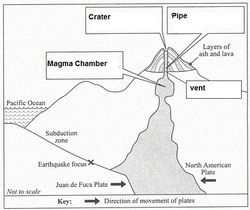
14. Draw a cross-section of a volcano and label the features: layers of lava and ash,vent, pipe, crater, magma chamber.
15. Identify and explain the formation of volcano and lava plateau.
a) Volcano: At the zone of subduction of two converging plates, the magma is displaced.The hot molten rock materials push their way onto the earth's surface upon pressure release along lines of weakness and escape through a vent in the crust. The lava cools upon contact with the atmosphere and solidifies layer upon layer to form a cone-shaped structure called a volcano.
b) lava plateau: It is formed by outflow of lava along fissures(cracks). It is often dissected by rivers. It weathered to form deep, fertile black soil. e.g. Deccan Plateau
16. Identify and explain the formation of intrusive features such as sill, dyke, batholith
When magma cools and solidifies within the earth's crust without reaching the earth's surface, it form intrusive volcanic features such as sill, dyke and batholith. A sill is formed along bedding planes dyke is formed when magma cuts through layers of sedimentary rock before it cools and solidifies. A batholith is formed when magma cools and solidifies to form a large crystalline rock deep below the crust.
17. Define the terms active, dormant and extinct volcano and to give an e.g. for each.
a) active volcano: shows sign of activities recently. e.g. Mt . Mayon in Philippines
b) dormant volcano: has not erupted recently but will erupt again e.g. Mt Fuji, Japan
c) extinct volcano: will not erupt again e.g. Kilimanjaro (Tanzania)
18. Explain the formation of basic lava cone, acid lava cone, ash and cinder cone and composite volcano with labelled diagrams and an example for each.
a) Acid lava cone is made up of viscous acid lava with high silica content. The acid lava solidifies quickly and does not travel far forming steep convex slopes. It is associated with violent and sporadic eruption. e.g. Mt Mayon
b) basic lava cone is also called a volcanic shield. It is made up of fluid lava with low silica content.It is more mobile and spreads away from the vent before it solidifies forming gentle concave slopes. It is associated with quiet eruption e.g. Mauna Loa (Hawaii)
c) Ash and cinder cone is formed by the successive ejection and accumulation of solid pyroclastic materials. The periodic and violent eruptions cause alternate layers of ash and cinder. e.g. Vulcano (Italy)
d) Composite cone has a stratified structure. There is periodic violent eruptions with alternate layers of lava and ash accumulated.It is high with steep slopes near the summit and gradient decreases toward the base. Parasitic cones develop due to the development of cracks during violent eruptions. e.g. Mt Fujiyama in Japan
19. Describe the formation of caldera, crater lake and volcanic plug and to give an e.g for each.
When magma in the crater and vent solidifies, a cap of solid rock called a plug is formed above the molten material. e.g. Mont Pelee on the island of Martinique.
The plug may prevent magma from passing up the vent and massive pressure builds up,swelling the volcano's base.This may eventually cause a very violent eruption which shatters the top of the volcano into a huge depression called a caldera. Water may fill the caldera to form crater lake such as Lake Toba in Sumatra, Indonesia.
20. Explain the associated features of vulcanicity: hotsprings, fumarole and geysers
a) Hotspring: As groundwater is heated by contact with magma, the superheated groundwater flows quietly in a volcanic region as hotspring.
e.g. Tangkuban Prahu in Java
b) a fumarole refers to the ejection of gases or steam only from the thermal heating of magma.
c) geyser: It is a fountain of hot water and superheated steams which is ejected onto the surface at Intervals. e.g. Old faithful in Yellowstone park,USA
21. Describe the benefits of vulcanicity to man.
a) volcanic regions are often rich in sulphur deposits which can be mined for industrial use.
b) basic lava often produce fertile soil after weathering which is suitable for cultivation.
e.g. fertile volcanic soils in Java and Deccan Plateau in India
c) geothermal power may be utilised for making steam to generate electricity e.g. New Zealand gets 10% of her power supply from geothermal energy.
d) Volcanic areas offer spectacularly beautiful attractions for tourists. e.g Mt Fuji in Japan
e) Volcanic ash can be used to surface roads and manufacture bricks
f) In some parts of the world, valuable materials such as gold, iron and diamonds
have been formed by volcanic activity, and large mining centres have developed.
22. Describe the problems of vulcanicity to man.
a) volcanic eruptions claim many lives and destroy buildings and property,
b) Poisonous gases such as compounds of sulphur, carbon monoxide and carbon dioxide are produced.
c)ash and volcanic dust ejected by volcanoes may be blown away to pollute the air
d) When snow-capped volcanoes erupt, a sudden flash flood will also result from the melting of snow and ice. Mudflow may also be produced.
23. What are the dangers faced after an earthquake?
There could still be aftershocks of lower magnitudes as there are adjustments to the repositioning of the fault. As many buildings are already weakened by the main shock, the aftershocks will cause more collapse and there will be more casualties. Dead animals and corpse will start to rot and if not disposed quickly, there might be an outbreak of epidemic such as Malaria.
23. Describe the cause of folding.
When the layer of rocks are compressed, the layers of rocks may be folded in a variety of ways. The upfold is called the anticline and the downfold is called the syncline.
15. Identify and explain the formation of volcano and lava plateau.
a) Volcano: At the zone of subduction of two converging plates, the magma is displaced.The hot molten rock materials push their way onto the earth's surface upon pressure release along lines of weakness and escape through a vent in the crust. The lava cools upon contact with the atmosphere and solidifies layer upon layer to form a cone-shaped structure called a volcano.
b) lava plateau: It is formed by outflow of lava along fissures(cracks). It is often dissected by rivers. It weathered to form deep, fertile black soil. e.g. Deccan Plateau
16. Identify and explain the formation of intrusive features such as sill, dyke, batholith
When magma cools and solidifies within the earth's crust without reaching the earth's surface, it form intrusive volcanic features such as sill, dyke and batholith. A sill is formed along bedding planes dyke is formed when magma cuts through layers of sedimentary rock before it cools and solidifies. A batholith is formed when magma cools and solidifies to form a large crystalline rock deep below the crust.
17. Define the terms active, dormant and extinct volcano and to give an e.g. for each.
a) active volcano: shows sign of activities recently. e.g. Mt . Mayon in Philippines
b) dormant volcano: has not erupted recently but will erupt again e.g. Mt Fuji, Japan
c) extinct volcano: will not erupt again e.g. Kilimanjaro (Tanzania)
18. Explain the formation of basic lava cone, acid lava cone, ash and cinder cone and composite volcano with labelled diagrams and an example for each.
a) Acid lava cone is made up of viscous acid lava with high silica content. The acid lava solidifies quickly and does not travel far forming steep convex slopes. It is associated with violent and sporadic eruption. e.g. Mt Mayon
b) basic lava cone is also called a volcanic shield. It is made up of fluid lava with low silica content.It is more mobile and spreads away from the vent before it solidifies forming gentle concave slopes. It is associated with quiet eruption e.g. Mauna Loa (Hawaii)
c) Ash and cinder cone is formed by the successive ejection and accumulation of solid pyroclastic materials. The periodic and violent eruptions cause alternate layers of ash and cinder. e.g. Vulcano (Italy)
d) Composite cone has a stratified structure. There is periodic violent eruptions with alternate layers of lava and ash accumulated.It is high with steep slopes near the summit and gradient decreases toward the base. Parasitic cones develop due to the development of cracks during violent eruptions. e.g. Mt Fujiyama in Japan
19. Describe the formation of caldera, crater lake and volcanic plug and to give an e.g for each.
When magma in the crater and vent solidifies, a cap of solid rock called a plug is formed above the molten material. e.g. Mont Pelee on the island of Martinique.
The plug may prevent magma from passing up the vent and massive pressure builds up,swelling the volcano's base.This may eventually cause a very violent eruption which shatters the top of the volcano into a huge depression called a caldera. Water may fill the caldera to form crater lake such as Lake Toba in Sumatra, Indonesia.
20. Explain the associated features of vulcanicity: hotsprings, fumarole and geysers
a) Hotspring: As groundwater is heated by contact with magma, the superheated groundwater flows quietly in a volcanic region as hotspring.
e.g. Tangkuban Prahu in Java
b) a fumarole refers to the ejection of gases or steam only from the thermal heating of magma.
c) geyser: It is a fountain of hot water and superheated steams which is ejected onto the surface at Intervals. e.g. Old faithful in Yellowstone park,USA
21. Describe the benefits of vulcanicity to man.
a) volcanic regions are often rich in sulphur deposits which can be mined for industrial use.
b) basic lava often produce fertile soil after weathering which is suitable for cultivation.
e.g. fertile volcanic soils in Java and Deccan Plateau in India
c) geothermal power may be utilised for making steam to generate electricity e.g. New Zealand gets 10% of her power supply from geothermal energy.
d) Volcanic areas offer spectacularly beautiful attractions for tourists. e.g Mt Fuji in Japan
e) Volcanic ash can be used to surface roads and manufacture bricks
f) In some parts of the world, valuable materials such as gold, iron and diamonds
have been formed by volcanic activity, and large mining centres have developed.
22. Describe the problems of vulcanicity to man.
a) volcanic eruptions claim many lives and destroy buildings and property,
b) Poisonous gases such as compounds of sulphur, carbon monoxide and carbon dioxide are produced.
c)ash and volcanic dust ejected by volcanoes may be blown away to pollute the air
d) When snow-capped volcanoes erupt, a sudden flash flood will also result from the melting of snow and ice. Mudflow may also be produced.
23. What are the dangers faced after an earthquake?
There could still be aftershocks of lower magnitudes as there are adjustments to the repositioning of the fault. As many buildings are already weakened by the main shock, the aftershocks will cause more collapse and there will be more casualties. Dead animals and corpse will start to rot and if not disposed quickly, there might be an outbreak of epidemic such as Malaria.
23. Describe the cause of folding.
When the layer of rocks are compressed, the layers of rocks may be folded in a variety of ways. The upfold is called the anticline and the downfold is called the syncline.
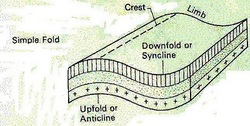
24. Draw a simple fold and name the parts.
25. Draw and name the types of fold: symmetrical, assymetrical fold, overfold, recumbent fold and overthrust.
26. Describe the formation of fold mountains with the aid of a diagram.
Over a long period of time, deep deposits build up and the sea bed sinks under this great weight. As plates move nearer, sediments are compressed to form an island in the sea. Further compression caused the layer of rocks to be folded. The anticlines form the fold mountains and the synclines became the sites of seas and valleys. e.g. The convergence of the Indo-Australian plate and the Eurasian plate results in the formation of the Himalayas.
27. Name the young fold mountains on a world map: Himalayas, Andes, Rockies,Alps and Andes.
28. Explain the cause of faulting.
Where relatively rigid part of the crust moves along the lines of weakness, faults are formed. The layers of rocks are displaced horizontally or vertically along the fault lines.
It can be caused by either tensional or compressional forces which are applied to rocks either laterally or vertically.
29. Draw a diagram of a normal fault and label the following: fault line, upthrow downthrow, scarp.
25. Draw and name the types of fold: symmetrical, assymetrical fold, overfold, recumbent fold and overthrust.
26. Describe the formation of fold mountains with the aid of a diagram.
Over a long period of time, deep deposits build up and the sea bed sinks under this great weight. As plates move nearer, sediments are compressed to form an island in the sea. Further compression caused the layer of rocks to be folded. The anticlines form the fold mountains and the synclines became the sites of seas and valleys. e.g. The convergence of the Indo-Australian plate and the Eurasian plate results in the formation of the Himalayas.
27. Name the young fold mountains on a world map: Himalayas, Andes, Rockies,Alps and Andes.
28. Explain the cause of faulting.
Where relatively rigid part of the crust moves along the lines of weakness, faults are formed. The layers of rocks are displaced horizontally or vertically along the fault lines.
It can be caused by either tensional or compressional forces which are applied to rocks either laterally or vertically.
29. Draw a diagram of a normal fault and label the following: fault line, upthrow downthrow, scarp.
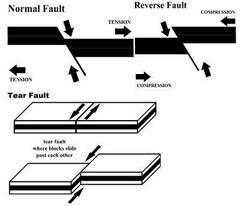
30. Draw and explain the types of faults: normal, reverse and tear.
31. Explain the formation of a horst, block mountain.
A block mountain refers to a block of crust which is uplifted due to faulting,the smaller of which are called horst. It is formed when a block of crust remains standing tall due to the sinking of the crust on either side of a pair of faults or the uplifting of a rock mass between two faults. e.g. Black Forest in the Rhine Basin.
32. Explain the formation of a graben, rift valley with the aid of diagrams
Rift valleys are steep-sided trenches, the smaller of which are sometimes called graben.
They are caused by either subsidence of a section of the crust between two faults when tensional forces are applied, or then the land on either side of two parallel faults are uplifted due to compression. e.g. East African rift valley
31. Explain the formation of a horst, block mountain.
A block mountain refers to a block of crust which is uplifted due to faulting,the smaller of which are called horst. It is formed when a block of crust remains standing tall due to the sinking of the crust on either side of a pair of faults or the uplifting of a rock mass between two faults. e.g. Black Forest in the Rhine Basin.
32. Explain the formation of a graben, rift valley with the aid of diagrams
Rift valleys are steep-sided trenches, the smaller of which are sometimes called graben.
They are caused by either subsidence of a section of the crust between two faults when tensional forces are applied, or then the land on either side of two parallel faults are uplifted due to compression. e.g. East African rift valley

